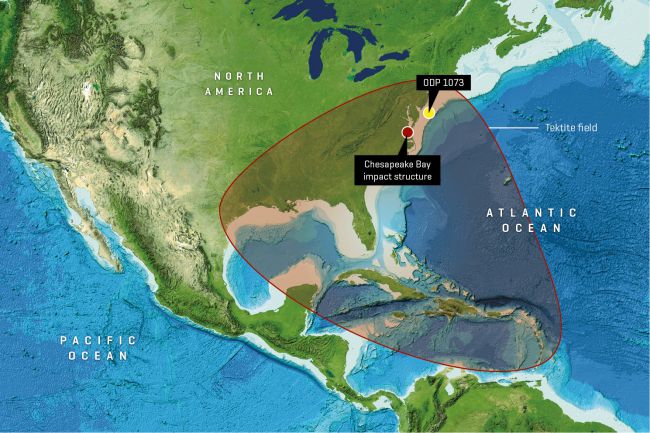America's Largest Asteroid Impact Left a Trail of Destruction Across the Eastern United States
America's largest impact crater wreaked havoc on the land and water. Scientists are just beginning to understand it.

About 35 million years ago, an asteroid traveling nearly 144,000 mph (231,000 km/h) smashed into the Atlantic Ocean near the modern-day town of Cape Charles, Virginia. The space rock vaporized instantly, but its impact triggered a gargantuan tsunami, cast up a monsoon of shattered rocks and molten glass that spanned hundreds of miles and carved out the single largest crater in the United States — the so-called Chesapeake Bay impact structure.
Today, that 25-mile-wide (40 kilometers) crater is buried half a mile below the rocky basement of Chesapeake Bay — the 200-mile-long (320 km) estuary linking Virginia and Maryland on the East Coast. That hasn't stopped scientists from trying to piece together the site's mysterious history since it was first discovered during a drilling project in 1990.
In a recent study of ocean sediment cores taken almost 250 miles (400 km) northeast of the impact site, researchers found traces of radioactive debris dating to the time of the strike, providing fresh evidence of the impact's age and destructive power.
Related: Crash! The 10 Biggest Impact Craters on Earth
When the Chesapeake Bay impactor smashed into the Atlantic, it showered the surrounding land and water with shards of molten glass (known as "tektites") for hundreds of miles in every direction. This rain of meteoric debris formed what scientists call the North American tektite strewn field, the study authors wrote, which stretches from Texas to Massachusetts to Barbados, covering about 4 million square miles (10 million square km) of terrain. By studying shards of meteoric rock buried deep within this sweeping field of impact wreckage, scientists can gather clues about the asteroid's key characteristics, including its age.

In their recent study (published June 21 in the journal Meteoritics and Planetary Science), researchers from Arizona State University dated 21 microscopic shards of zircon — a durable gemstone that can survive underground for billions of years. These zircons were lodged in a sediment core taken from roughly 2,150 feet (655 meters) below the Atlantic Ocean. Not only is zircon commonly found in tektites, but it is also a choice mineral for radiometric dating, thanks to some of its radioactive elemental components.
In this case, the researchers used a dating technique called uranium–thorium–helium dating, which looks at how radioactive isotopes, or versions, of uranium and thorium decay into helium. By comparing the ratios of specific helium, thorium and uranium isotopes in each mineral sample, the researchers calculated approximately how long ago the zircon crystals solidified and started to decay.
Get the Space.com Newsletter
Breaking space news, the latest updates on rocket launches, skywatching events and more!
The team found that the 21 crystals ranged widely in age, running the gamut from about 33 million to 300 million years old. The two youngest samples, which had an average age of about 35 million years old, fit in with previous studies' estimates for the time of the Chesapeake Bay impact. A closer examination showed that the zircons also bore a cloudy appearance and deformed surface, two signs the minerals were kicked through the air and water by a great impact.
The team concluded that these two young crystals were part of the Chesapeake impact's path of destruction, confirming that the impact occurred about 35 million years ago. Moreover, the researchers wrote, it showed that uranium–thorium–helium dating is a viable method for constraining the age of ancient impact events, giving scientists a fresh tool to reveal our planet's long and violent past.
- Fallen Stars: A Gallery of Famous Meteorites
- The 12 Strangest Objects in the Universe
- Top 10 Ways to Destroy Earth
Originally published on Live Science.
Join our Space Forums to keep talking space on the latest missions, night sky and more! And if you have a news tip, correction or comment, let us know at: community@space.com.

Brandon has been a senior writer at Live Science since 2017, and was formerly a staff writer and editor at Reader's Digest magazine. His writing has appeared in The Washington Post, CBS.com, the Richard Dawkins Foundation website and other outlets. He holds a bachelor's degree in creative writing from the University of Arizona, with minors in journalism and media arts. He enjoys writing most about space, geoscience and the mysteries of the universe.










